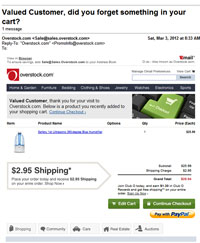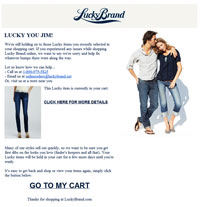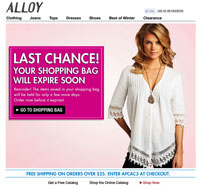The Eagles sang, “You can check out any time you like, but you can never leave.” For 87% of today’s marketers, however, “You can abandon checkout anytime you like and we will let you go” would be more fitting.
 |
With 72% of carts abandoned (an increase from previous industry benchmarks), it’s shocking that such a large percentage of brands are not sending any form of post-abandonment marketing messages.
Post-abandonment emails need to be part of your marketing strategy. The fact is, abandoned cart emails work. Conversion rates of 20% are common, and open rates twice that of promotional emails can be expected.
Let’s review samples of real-world abandoned cart emails to see what strategies you can incorporate into your own post-abandonment program.
Overstock.com
The first of two abandoned cart emails is sent within 24 hours after abandonment, a prime time when the product and shopping experience are still fresh in the mind of the abandoner.
The “cart” is referenced in the subject line, setting the expectation of the message’s content and explaining why the email has been sent.
The email creative visually echoes the on-site carting experience, placing shoppers back in the moment when they abandoned. The carted product image, link, quantity and per-unit price are displayed. Perhaps more important, the subtotal, shipping charges and grand total are also shown.
Considering that the total order cost is one of the main contributors to cart abandonment, having this information spelled out in the email can help avoid any surprises when the shopper revisits the cart.
The list of reasons someone abandons is quite long, and you can never be completely certain which one reason led to any one abandonment. Therefore, presenting options that give the subscriber various ways to proceed, rather than a confusing or vague path, can lead to a conversion. Overstock provides options to edit the cart or continue to checkout. This gives shoppers an opportunity to change quantities or remove products that they no longer want to purchase before feeling like they are re-entering the checkout process.
What Doesn’t Work
Unlike standard promotional emails, abandoned cart messages are an unexpected communication. Marketers must keep a balance between providing a helpful service and being too “big brother-ish.” The use of “Valued Customer” in the subject line and body of the message is a miss. If you do not have a first name for a subscriber, then use a different subject line or dynamic content to remove the personalization.
Lucky Brand
What Works
Lucky Brand sends the first of two post-abandonment emails within a few hours of abandonment. While there is no silver bullet when it comes to timing, quickly reminding shoppers about their carts after abandonment can discourage comparison shopping—especially in an industry like apparel.
Three lines of copy in the first paragraph are dedicated to apologizing for potential technical issues experienced while shopping. This could be effective if your site is prone to crashes, but the scenario may not apply to all shoppers and could cause confusion.
A customer service phone number and email address provide alternative methods of getting assistance or completing an order, which could be helpful if the shopper is not comfortable completing the purchase online or has questions.
What Doesn’t Work
Lucky Brand leverages a few data points in the email: first name, carted product picture, and a link to the cart. While this information is helpful, the organization and layout are confusing. Shoppers may not remember what they carted, and the lack of product name, price, quantity and shipping costs makes this email seem more like a newsletter than an abandoned cart reminder.
In addition to being in all caps, the call-to-action of “CLICK HERE FOR MORE DETAILS” does not set the expectation that the shopper will either return to the product page or the cart, or re-enter the checkout process.
Providing the option to visit a nearby store could be helpful for some customers, but considering that the zip code is provided during checkout, a more effective method would be dynamically populating specific store information. If store information is not available, link to your store locator.
Overall, the email depends on too much copy. Many sections of the email attempt to tackle causes for abandonment, but the copy could be more succinct and presented in a more digestible format.
Alloy
What Works
All hope is not lost if you do not have the technical capability to include cart data. Alloy may be able to populate cart data, but its two-part abandonment series is different from the other examples. The first message uses the friendly-reminder tone in its subject line: “You Left Some Things in Your Shopping Bag + Get FREE Shipping!” How nice of them. A polite reminder and a free shipping offer!
The email creative is a soothing beach-like scene with a notice that my cart will expire “in a few days.” No sense of urgency. This approach can be effective if you expect your customers to have a negative reaction to an abandoned cart reminder.
In contrast, the second message shifts to a more urgent subject line of “Hurry, Your Shopping Bag Expires Soon!” The email creative uses a much bolder color palette and an all-caps “LAST CHANCE!” headline. The piercing stare of the model suggests that you’d better do something now or she might get angry. Who knows what she’s holding behind her back?
While some of the other examples used cart imagery to put the subscriber back in the shopping mindset, or copy to combat causes for abandonment, Alloy takes a more visual approach to remind the subscriber and reinforce urgency.
What Doesn’t Work
The two-part series could contain more data about the carted items. But some brands may have technical or resource limitations in this regard. If so, the approach used by Alloy is one to consider.
Additionally, the incentive of free shipping was offered in the first email. Using the first post-abandonment message as a reminder could be enough to gain the conversion without sacrificing your margin.
Jim Davidson (
[email protected]) is manager of marketing research for Bronto Software (
www.bronto.com).




